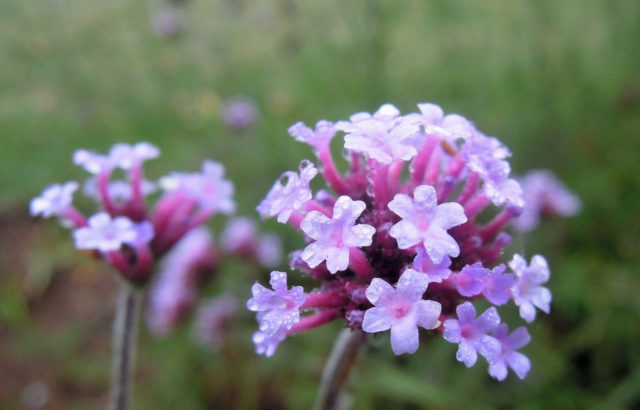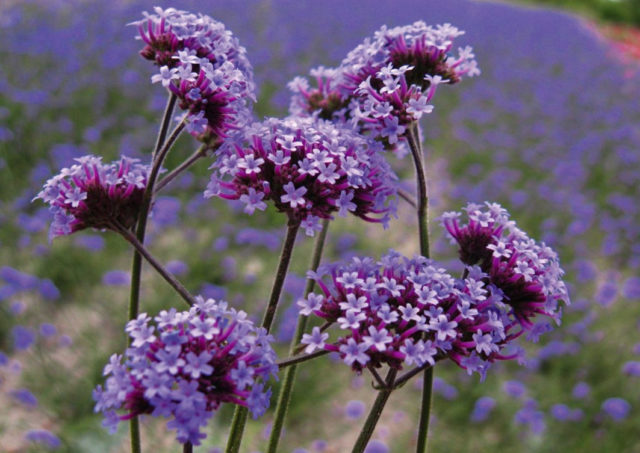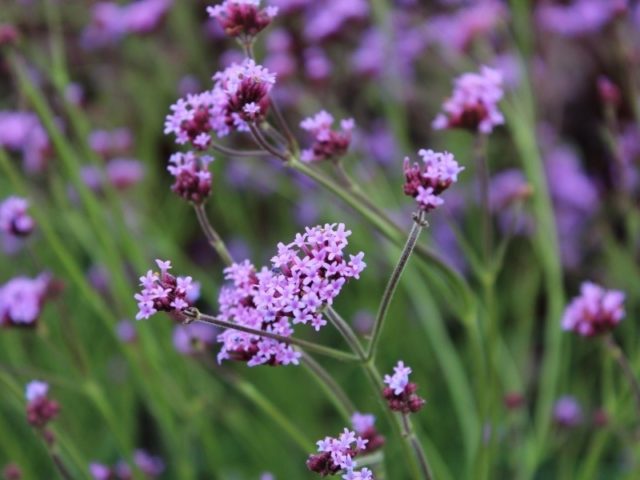Content
Verbena Bonarskaya is an elegant decoration of the garden. Its small weightless flowers seem to float in the air, exuding a delicate aroma. This unusual type of verbena is successfully integrated into various styles of decorating personal plots. It looks equally good in single and group fit.

Verbena "Buenos Aires" begins to bloom in early July until late autumn
Description of Bonar Verbena
"Bonar" or "Buenos Aires" vervain is very different from the rest of its kind. First of all, it is distinguished by small purple flowers collected in umbrella-shaped inflorescences. They decorate the plant from spring or early summer until the very frost, without changing the appearance and exuding a delicate aroma. The height of the Bonarskoy verbena, depending on the variety, ranges from 60-120 cm. The strong and thin erect trunk forms an umbrella of peduncles in the upper part.
The second name of the Bonar verbena comes from a city in South America - Buenos Aires. It is in such a warm and sunny climate that culture is used to living. This perennial plant in the middle lane is grown as an annual, as it dies during severe winter frosts. However, the culture calmly tolerates a relatively slight cold snap, therefore, decorates the site until late autumn.
Bonar Verbena varieties
Verbena "Bonarskaya" is represented by varieties that differ in shades of flowers, trunk height and other biological characteristics.
The most popular are:
- Little one - a variety of perennial verbena "Bonarskoy" is distinguished by its small growth - up to 60 cm. On powerful trunks, pink-purple inflorescences are formed. The plant blooms from spring to autumn, does not produce seeds. Ideal for front and middle curbs.
- Finesse - the bush reaches 90 cm in height. Lush purple inflorescences appear in summer and wither with the first frost. The plant looks great when planted massively in rows, as well as in combination with other ornamental crops. The variety is capable of self-seeding.
- Purple rain - the base reaches a height of 120 cm, branches from the end of June to autumn are decorated with balls of small lilac flowers. In a flower garden, it plays the role of a background, an element of a combination or a dominant plant.
Application in landscape design
The indisputable advantage of the Bonarskaya verbena is its long flowering. It lasts throughout the summer, so there is no need to select a replacement for the plant in the created composition. The even distribution of Bonarskoy verbena over the flower garden will emphasize the beauty of large flowering plants. It is in harmony with contrasting and similar in color plants.
Dense mono-planting of the culture becomes the dominant element of the composition. It goes well with tall grasses from the cereal family and many perennials. The beauty and tenderness of the Bonarskoy verbena is favorably emphasized by the background of conifers. It is often used to make a curb strip. The culture looks spectacular in the form of a frame for garden paths.
Breeding features
Gardeners practice three ways to reproduce verbena:
- Seed in open ground. This approach is ineffective due to poor seed germination and late onset of flowering.
- Cuttings. In the fall, several bushes are dug up and moved to a cool room, and in early spring they begin to reproduce.
- Growing seedlings. The easiest and most effective way to reproduce verbena.
Growing Bonar Verbena from seeds
The seeds of the Bonarskoy verbena have a low germination rate, therefore, sowing in open ground is rarely practiced. Growing seedlings is the best option for breeding a culture. First, it makes it possible to create the most suitable conditions for seed germination and the formation of healthy stems. Secondly, the exact number of shoots obtained is known in advance.
To get strong and healthy seedlings, you need to pay special attention to the following points:
- sowing time;
- capacity;
- priming;
- landing algorithm;
- seedling care.
Sowing dates
About 2 months pass from the moment of sowing the seeds of the Bonarskaya verbena until the long-awaited purple inflorescences appear on it. Based on this, calculate the optimal date for the start of growing seedlings. In the middle lane, it is better to sow seeds in mid-March, in the northern regions - in the first half of April.
Given the poor germination of verbena, many gardeners sow seeds in two passes. Already one to two weeks after the first planting in March, young shoots are shown. The missing seedlings are obtained by re-sowing the seeds.
Tank and soil preparation
For growing seedlings of Bonarskoy verbena, it is convenient to use wide plastic containers. It is necessary to prepare in advance a package that can cover its entire surface.
Sowing seeds is carried out in purchased soil for seedlings or disinfected garden soil. You can add sand, vermiculite, or humus to your homemade substrate. A two-component mixture of peat and sand is also suitable.
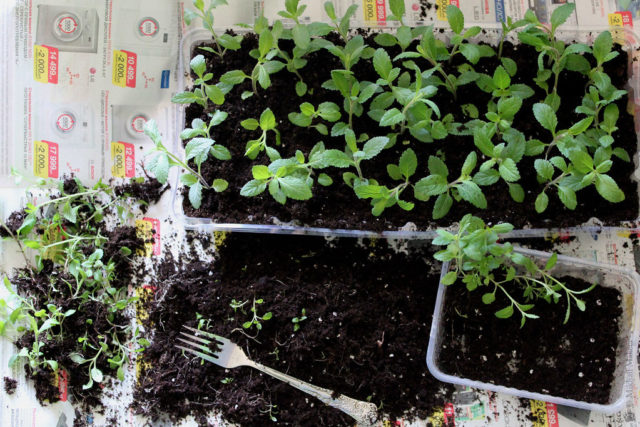
Verbena prefers light and fertile soil
Landing rules
The seeds of Bonarskaya verbena should be prepared before planting. To do this, they are laid out on gauze or cotton wool moistened with warm water or stimulating solution. Cover with plastic wrap on top. After 2-3 days, sowing is started.
Seed planting algorithm:
- The surface of the soil is leveled and moistened with water or a solution of a growth stimulant.
- Spread the seeds evenly with your hands or tweezers.
- Cover the container with a plastic bag.
Growing Buenos Aires Verbena seedlings
Before sprouts appear, the following guidelines should be applied:
- Maintain the temperature within 18-25 ° C.
- Water with a spray bottle after the topsoil is completely dry.
- Ventilate the greenhouse regularly and remove condensation.
As soon as the young sprouts appear, they need to provide good lighting. After the formation of 3-4 leaves, they are seated in small separate containers. Two weeks later, watered with a solution of mineral fertilizer. Then cut off the top to enhance branching.
Growing Bonar verbena outdoors
In order for the Buenos Aires verbena to look as attractive as in the photo from the seed packaging, a number of conditions must be met. It requires a sunny area. In extreme cases, partial shade is acceptable. The soil should be light and nutritious. In many cases, gardeners have to add sand to it.
Landing in open ground is usually done in May. The exact date is set depending on the region and the weather in the current year. At this point, there should be a stable positive temperature and a minimum risk of recurrent frost.
Transplanting seedlings
Planting of seedlings of verbena "Bonarskoy" is carried out according to the following rules:
- the earthen lump must be preserved;
- the distance between neighboring plants is 20-30 cm;
- a drainage layer must be made at the bottom of each hole.
Stagnant water is detrimental to verbena, so sand or expanded clay is poured onto the bottom of the holes. After planting, the seedlings are watered. From above, the soil can be sprinkled with sand, sawdust or needles.
Watering and feeding
The sun quickly dries up the soil in which the Bonarskaya verbena grows, so you need to carefully monitor the soil moisture. The most abundant watering is needed for the culture during the period of budding and flowering. It should be cut in the fall. Water should not be allowed to stagnate at the roots.
The plant does not need frequent feeding. It is enough to apply organic or mineral fertilizer 2-3 times a year. It is better to combine this event with watering. If you oversaturate the verbena with nutrients, all its strength will be spent on building up green mass, and flowering will be scarce.
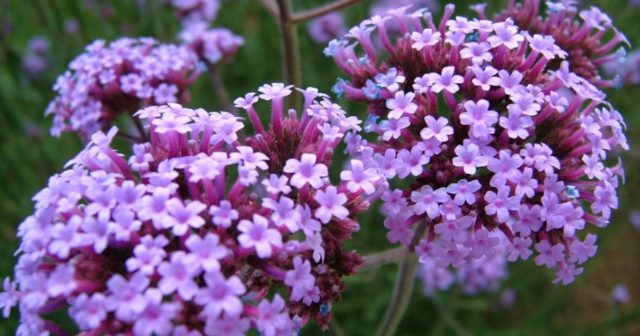
During the flowering period, Bonarskaya vervain needs increased watering
Loosening, weeding, mulching
The first weeks after planting seedlings, the soil will often have to be weeded and loosened. Later, when the Bonarskaya verbena bushes grow, these activities can be stopped. The dense branches and branched roots of the plant will prevent weeds from breaking through. This can be facilitated by mulch, which is used as shavings, sawdust or needles.
Wintering
Perennial Verbena "Bonarskaya" has become an annual crop in the middle lane and northern regions. The minimum temperature that it can withstand is -3 ° C. She does not tolerate winter frosts, even with the most powerful shelter. Therefore, in October, the vervain is removed from the site.
If the gardener plans to propagate verbena by cuttings in the spring, a few bushes should be dug up in the fall. They must be kept in a cool place until March. Seeds are collected for sowing at the end of the season. Ripe bolls are dried, and then the seeds are removed.
Pests and diseases
Verbena resists disease well. But in a warm rainy period, she is threatened with fungal diseases: powdery mildew and various rot. The affected areas should be removed immediately, and the rest of the plant should be treated with an appropriate fungicide. Basic measures to prevent disease:
- moderate watering;
- removal of wilted inflorescences;
- elimination of weeds.
Verbena "Bonarskaya" can become a victim of two types of pests: miner flies and aphids. They gradually destroy the leaves of the plant. For prevention, a regular inspection of the flower is carried out and they are sprayed with special preparations.
Conclusion
Verbena Bonarskaya is a light-loving and heat-loving plant. Its weightless lilac inflorescences look perfect in a dense group planting, perfectly complement various flower beds. When growing a crop in conditions suitable for it, it will delight with strong stems and an abundance of delicate flowers until the first autumn frosts.
